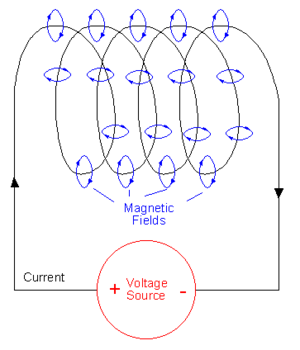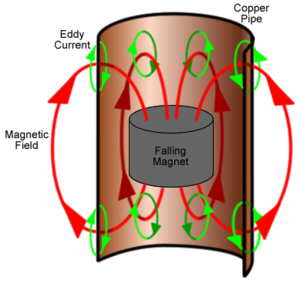Eddy Current: Difference between revisions
No edit summary |
No edit summary |
||
| Line 1: | Line 1: | ||
[[Image: |
[[Image:Eddy1.png|thumb|Figure 1. Induced magnetic fields in a loaded coil.]] |
||
Eddy current is an electrical phenomenon that occurs when a conductor is exposed to a varying magnetic field which causes a current flow within the conductor. |
Eddy current is an electrical phenomenon that occurs when a conductor is exposed to a varying magnetic field which causes a current flow within the conductor. |
||
| Line 6: | Line 6: | ||
== How does it work? == |
== How does it work? == |
||
[[Image: |
[[Image:Eddy2.png|thumb|Figure 2. Eddy currents.]] |
||
Whenever a current travels in a coil, a magnetic field, or electromagnetic induction, is produced around the coil. This is explained by the Faraday's Law of Induction, which states that a change in the magnetic environment of a coil will induce an electromagnetic force in the coil. The polarity of that emf generated by the change in magnetic flux will also produce a current whose magnetic field is opposed to the change that produces it. This is know as Lenz's Law. |
Whenever a current travels in a coil, a magnetic field, or electromagnetic induction, is produced around the coil. This is explained by the Faraday's Law of Induction, which states that a change in the magnetic environment of a coil will induce an electromagnetic force in the coil. The polarity of that emf generated by the change in magnetic flux will also produce a current whose magnetic field is opposed to the change that produces it. This is know as Lenz's Law. |
||
Latest revision as of 03:13, 20 January 2010
Eddy current is an electrical phenomenon that occurs when a conductor is exposed to a varying magnetic field which causes a current flow within the conductor.
Why "Eddy"?
An Eddy is a term used in fluid mechanics which describes a fluid's swirl and its reverse current after the fluid has overcome an obstacle, like those produced by a dragging oar. A similar phenomenon occurs when a current is induced in a large conductor.
How does it work?
Whenever a current travels in a coil, a magnetic field, or electromagnetic induction, is produced around the coil. This is explained by the Faraday's Law of Induction, which states that a change in the magnetic environment of a coil will induce an electromagnetic force in the coil. The polarity of that emf generated by the change in magnetic flux will also produce a current whose magnetic field is opposed to the change that produces it. This is know as Lenz's Law.
Applications
Eddy current is used as a method of measurement, inspection of defects, and correction.

